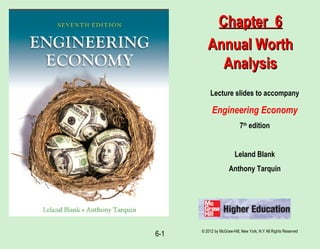
Chapter 6 annual worth analysis
- 1. © 2012 by McGraw-Hill, New York, N.Y All Rights Reserved 6-1 Lecture slides to accompany Engineering Economy 7th edition Leland Blank Anthony Tarquin Chapter 6Chapter 6 Annual WorthAnnual Worth AnalysisAnalysis
- 2. 6-2 LEARNINGLEARNING OUTCOMESOUTCOMES 1. Advantages of AW 2. Capital Recovery and AW values 3. AW analysis 4. Perpetual life 5. Life-Cycle Cost analysis © 2012 by McGraw-Hill All Rights Reserved
- 3. 6-3 Advantages of AW AnalysisAdvantages of AW Analysis AW calculated for only one life cycle Assumptions: Services needed for at least the LCM of lives of alternatives Selected alternative will be repeated in succeeding life cycles in same manner as for the first life cycle All cash flows will be same in every life cycle (i.e., will change by only inflation or deflation rate) © 2012 by McGraw-Hill All Rights Reserved
- 4. 6-4 Initial investment, P – First cost of an asset Salvage value, S – Estimated value of asset at end of useful life Annual amount, A – Cash flows associated with asset, such as annual operating cost (AOC), etc. © 2012 by McGraw-Hill All Rights Reserved Alternatives usually have the following cash flow estimates Relationship between AW, PW and FW AW = PW(A/P,i%,n) = FW(A/F,i%,n) n is years for equal-service comparison (value of LCM or specified study period)
- 5. 6-5 Calculation of Annual WorthCalculation of Annual Worth An asset has a first cost of $20,000, an annual operating cost of $8000 and a salvage value of $5000 after 3 years. Calculate the AW for one and two life cycles at i = 10% AWone = - 20,000(A/P,10%,3) – 8000 + 5000(A/F,10%,3) = $-14,532 AWtwo = - 20,000(A/P,10%,6) – 8000 – 15,000(P/F,10%,3)(A/P,10%,6) + 5000(A/F,10%,6) = $-14,532 AW for one life cycle is the same for all life cycles!! © 2012 by McGraw-Hill All Rights Reserved
- 6. Capital Recovery and AWCapital Recovery and AW Capital recovery (CR) is the equivalent annual amount that an asset, process, or system must earn each year to just recover the first cost and a stated rate of return over its expected life. Salvage value is considered when calculating CR. CR = -P(A/P,i%,n) + S(A/F,i%,n) Use previous example: (note: AOC not included in CR ) CR = -20,000(A/P,10%,3) + 5000(A/F,10%,3) = $ – 6532 per year Now AW = CR + A AW = – 6532 – 8000 = $ – 14,532 6-6 © 2012 by McGraw-Hill All Rights Reserved
- 7. Selection Guidelines for AW AnalysisSelection Guidelines for AW Analysis 6-7 © 2012 by McGraw-Hill All Rights Reserved
- 8. 6-8 Solution: ME Alternative Evaluation by AWME Alternative Evaluation by AW Not necessary to use LCM for different life alternatives A company is considering two machines. Machine X has a first cost of $30,000, AOC of $18,000, and S of $7000 after 4 years. Machine Y will cost $50,000 with an AOC of $16,000 and S of $9000 after 6 years. Which machine should the company select at an interest rate of 12% per year? AWX = -30,000(A/P,12%,4) –18,000 +7,000(A/F,12%,4) = $-26,412 AWY = -50,000(A/P,12%,6) –16,000 + 9,000(A/F,12%,6) = $-27,052 Select Machine X; it has the numerically larger AW value © 2012 by McGraw-Hill All Rights Reserved
- 9. 6-9 AW of Permanent InvestmentAW of Permanent Investment Solution: Find AW of C over 5 years and AW of D using relation A = Pi Select alternative C Use A = Pi for AW of infinite life alternatives Find AW over one life cycle for finite life alternatives Compare the alternatives below using AW and i = 10% per year C D First Cost, $ -50,000 -250,000 Annual operating cost, $/year -20,000 -9,000 Salvage value, $ 5,000 75,000 Life, years 5 ∞ AWC = -50,000(A/P,10%,5) – 20,000 + 5,000(A/F,10%,5) = $-32,371 AWD = Pi + AOC = -250,000(0.10) – 9,000 = $-34,000 © 2012 by McGraw-Hill All Rights Reserved
- 10. 6-10 Typical Life-Cycle Cost Distribution by PhaseTypical Life-Cycle Cost Distribution by Phase © 2012 by McGraw-Hill All Rights Reserved
- 11. 6-11 Life-Cycle Cost AnalysisLife-Cycle Cost Analysis LCC analysis includes all costs for entire life span, from concept to disposal Best when large percentage of costs are M&O Includes phases of acquisition, operation, & phaseout © 2012 by McGraw-Hill All Rights Reserved Apply the AW method for LCC analysis of 1 or more cost alternatives Use PW analysis if there are revenues and other benefits considered
- 12. 6-12 Summary of Important PointsSummary of Important Points AW method converts all cash flows to annual value at MARR AW comparison is only one life cycle of each alternative Alternatives can be mutually exclusive, independent, revenue, or cost For infinite life alternatives, annualize initial cost as A = P(i) Life-cycle cost analysis includes all costs over a project’s life span © 2012 by McGraw-Hill All Rights Reserved
